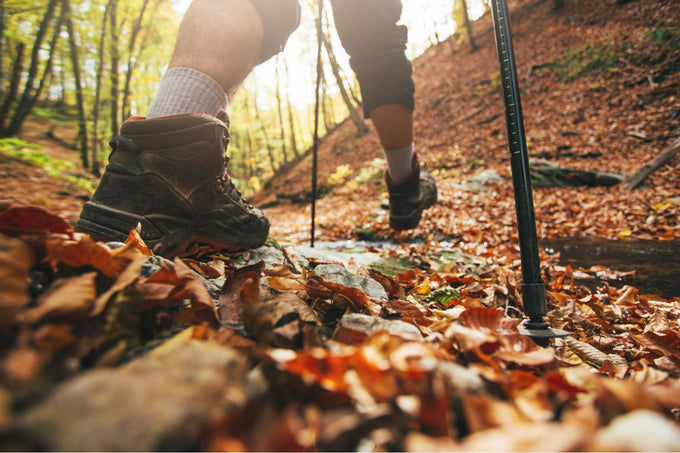Pack Smart and Safe: Fall Hiking Essentials

Hiking seems to bring extra enjoyment to crisp autumn air and fall foliage. Whether you’re an avid hiker or just dipping your toes in, reviewing the basics of wilderness safety and appropriate equipment will benefit you as you enter this hiking season.
What to Pack for a Hike
Wilderness First-Aid Kit
Brushing up on wilderness first-aid basics before a hike will end up saving you time and energy in the long run. Consider taking a wilderness first-aid course, especially if you don’t have a medical background or feel comfortable with treating injuries.
The most common minor to moderate hiking injuries includes bug bites, scratches, bruises, and sprained ankles. Pick up a first-aid kit for supplies to treat these ailments at any hiking store.
How to prevent an ankle injury:
- Pack durable, non-slip hiking shoes.
- Bring hiking poles (and review how to use them correctly if it’s your first hike with poles).
- Watch your footing.
What to pack in case of an ankle injury:
- Instant ice pack.
- Athletic tape/wrap (and instructions on how to properly wrap an ankle).
- Over-the-counter anti-inflammatory pain medication (check with your doctor on which medication is right for you).
Grab a wilderness first-aid pocket guide for more comprehensive safety tips, especially if hiking overnight or on technical terrain.
Cold Weather Gear
Another leading cause of hiking injuries is hypothermia (a significant drop in body temperature), which commonly occurs in cold, wet, or snowy environments. Staying dry is key in preventing temperature loss.
What to pack for the cold:
- Parka.
- Rain cover.
- Extra dry clothing, including socks.
- Instant heat pack and/or hand warmers.
- Active fleece.
Water to Stay Hydrated
Even in the fall and winter, pack water strategically. A rule of thumb for packing water is to bring about 1 liter of water every 2 hours of planned hiking, or about 2 cups per hour.
This could increase by double or more in summer, depending on the temperature and terrain. Even if you don’t feel thirsty, remember to stay hydrated throughout your journey.
Research the trail ahead of time to see if you need to pack all the necessary water, or if reliable water sources will be available during your hike.
Always have a backup water source, such as water purification tablets, a water filtration straw, or a way to boil water.
If you get halfway through your water supply and have no reliable upcoming water source, turn around and don’t risk it.
Sunscreen and UPF Clothing
Overcast and snowy weather cause UV light to be extra reflective. To avoid unnecessary visual strain, pack a UPF 50+ sun hat and sunglasses. Sunscreen is also still necessary, as the sun is still able to cause sunburns or UV damage in those conditions.
You can still get sunburned when it's cloudy too, so make sure you wear UPF clothing to keep your skin protected from the sun's UV rays. Look for the UPF 50+ rating for best-in-class sun protection.
Fatigue may set in more subtly on a temperate fall hike, but make sure to still plan to stop, take breaks, and eat periodically. Taking a small break about each hour is recommended to keep pace and tend to the physical and mental demands that hiking requires. This not only prevents injury but will also keep your mind alert and confident in your ability to complete the hike.
Final Thoughts
Hiking is the most relaxing when you’re prepared and can safely tackle your route. In addition to the above tips, don’t forget to do further research. Take a safety course, talk to park rangers, and get recommendations from outdoor equipment shops.
Have fun and be safe! Check out the selection at UV Skinz for all the sun protection clothing you need this season.







